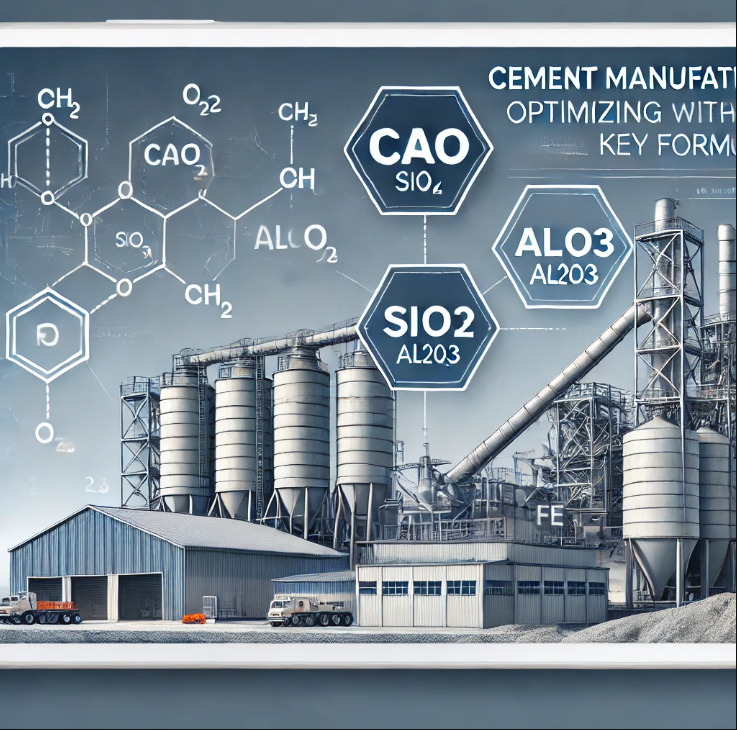Contents
Essential Cement Manufacturing Formulas and Their Applications

TO Download this post and all the books and excel sheets and my personal notes and presentations I collected about cement industry in the last 30 years click the below paypal link
Introduction:
Cement manufacturing is a crucial industry that forms the backbone of construction, and its processes are tightly regulated by a variety of chemical and mechanical principles. One key aspect of cement manufacturing is understanding and applying essential formulas that guide the production process. These formulas help manufacturers control the quality of raw materials, optimize chemical reactions, and ensure the final product meets industry standards. This post will explore the most critical formulas used in cement manufacturing, providing explanations and applications for each.
1. Lime Saturation Factor (LSF)
Lime Saturation Factor (LSF) is essential in ensuring the correct balance between lime (CaO) and other oxides such as silica, alumina, and iron oxide in cement production. LSF influences the clinker formation and overall strength of cement.
- Formula: LSF=CaO×1002.8SiO2+1.18Al2O3+0.65Fe2O3LSF = \frac{CaO \times 100}{2.8SiO_2 + 1.18Al_2O_3 + 0.65Fe_2O_3}
- Application:
It ensures that there is enough lime available for reactions, without exceeding the required amount that can cause free lime (CaO), leading to expansion problems.
2. Total Carbonate (TC)
Total Carbonate (TC) measures the total carbonate content in raw meal materials. This formula helps in controlling the calcination process by measuring the percentage of calcium carbonate (CaCO₃) and magnesium carbonate (MgCO₃).
- Formula: TC=CaO×10056+MgO×8440TC = \frac{CaO \times 100}{56} + \frac{MgO \times 84}{40}
- Application:
TC is crucial for determining the correct proportions of limestone and dolomite in the mix, which affects the thermal energy required for calcination.
3. Loss on Ignition (LOI)
Loss on Ignition (LOI) is the measure of weight loss when raw meal is heated to a high temperature. This gives insight into the volatile compounds, such as water and carbon dioxide, present in the material.
- Formula: LOI=(CaO×0.785)+(MgO×1.12)LOI = (CaO \times 0.785) + (MgO \times 1.12)
- Application:
LOI helps in adjusting the mix by ensuring the presence of non-volatile components that will form clinker during the kiln process.
4. Lime Saturation Factor (LSF) in Clinker
Once the clinker is formed, it’s important to monitor the LSF to ensure the clinker quality remains consistent. LSF in clinker differs slightly from the raw meal LSF.
- Formula: LSF=(CaO×100−0.7SO3)2.8SiO2+1.18Al2O3+0.65Fe2O3LSF = \frac{(CaO \times 100 – 0.7SO_3)}{2.8SiO_2 + 1.18Al_2O_3 + 0.65Fe_2O_3}
- Application:
Maintaining the right LSF in clinker controls free lime and reduces clinker reactivity, which is important for cement strength.
5. Tri-Calcium Silicate (C3S)
Tri-Calcium Silicate (C3S) is responsible for the early strength gain in cement. This formula is important for predicting the reactivity and setting time of the cement.
- Formula: C3S=4.07(CaO−FCaO)−(7.6SiO2+6.718Al2O3+1.43Fe2O3+2.85SO3)C3S = 4.07(CaO-FCaO) – (7.6SiO_2 + 6.718Al_2O_3 + 1.43Fe₂O₃ + 2.85SO₃)
- Application:
C3S directly contributes to the early strength of cement, and its optimal control ensures the cement sets within the expected timeframe for construction work.
6. Di-Calcium Silicate (C2S)
Di-Calcium Silicate (C2S) is responsible for long-term strength development. It hydrates more slowly than C3S and contributes to strength after several weeks.
- Formula: C2S=2.86SiO2+0.7544C3SC2S = 2.86SiO_2 + 0.7544C3S
- Application:
Controlling C2S levels is essential for ensuring the long-term durability of cement structures, especially in large projects where the concrete may be exposed to harsh environmental conditions.
7. Tri-Calcium Aluminate (C3A)
C3A contributes to the early heat of hydration and early setting time. It’s reactive with water and sulfate ions, which is important for managing the curing process.
- Formula: C3A=2.65Al2O3+1.692Fe2O3C3A = 2.65Al₂O₃ + 1.692Fe₂O₃
- Application:
The C3A content in cement affects sulfate resistance and should be optimized depending on the application (e.g., sulfate-resistant cement).
8. Tetra-Calcium Aluminoferrite (C4AF)
C4AF influences the color and clinker properties and plays a role in the liquid phase of cement during kiln heating.
- Formula: C4AF=3.04Fe2O3C4AF = 3.04Fe₂O₃
- Application:
The amount of C4AF determines the color and contributes to the formation of the liquid phase, which affects kiln operation and clinker cooling.
9. Sulphur Alkali Ratio (A/S)
The Sulphur Alkali Ratio (A/S) is used to control the clinker sulfur content, which can lead to operational problems in the kiln.
- Formula: A/S=SO380÷K2O94+(0.5Na2O62)A/S = \frac{SO₃}{80} \div \frac{K₂O}{94} + \left(\frac{0.5 Na₂O}{62}\right)
- Application:
A/S helps in reducing build-ups and ring formations in the kiln, ensuring a smoother operation and better clinker formation.
